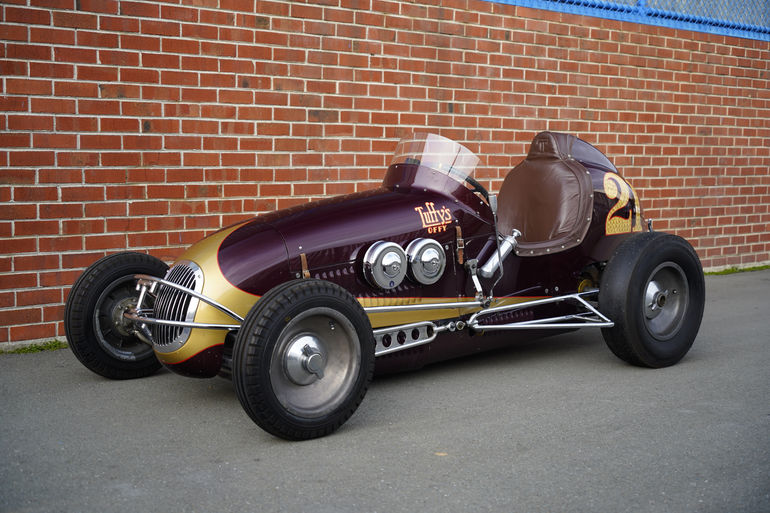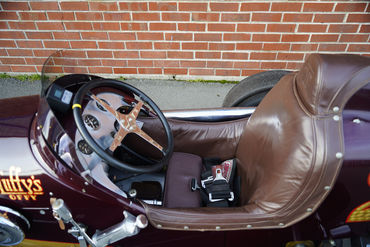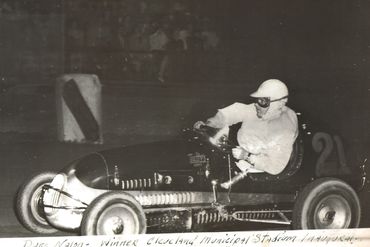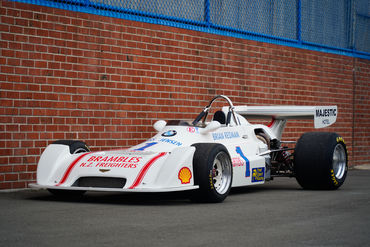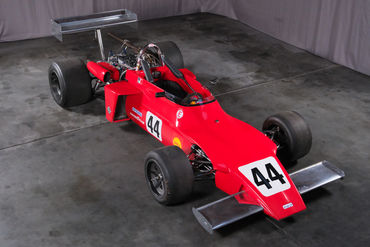Sold
SOLD 02/23
1947 Tuffy-Turner
Midget
Excellent correct restoration of a historic Offy-powered midget.
- VIN21
- Exterior ColorMaroon
- Interior ColorBrown
- MileageTMU
- EngineOffy
- Transmission
- StatusSold
- StockFJ2703
Description
1947 Tuffy-Turner Midget Race Car
Chassis Number – 21
Engine Number – 129
Exterior Color – Maroon Metallic with gold stripes and gold numeric livery
Interior Color – Chocolate brown
Engine Type – 4-cylinder DOHC Offenhauser
Gearbox – Single Forward Speed
Marque and Model History
In the 1940s and 50s, Midget Racing was second in popularity to Indy-type Champ car racing. Races at this time were considered major motorsports events offering high speed, chilling feats of daring, and the heart pounding sounds of high revving engines. Those hell-bent on competing at the higher levels of motorsports often cut their chops in Midget racing, proving their skills, and testing their courage. The product of legendary Indy 500 constructor Frank Kurtis, the Kurtis-Kraft Midget was produced for several years, supplying numerous racers with their cars. Designed and assembled at the Burbank, CA facility, by late 1946 Kurtis became overwhelmed by the increasing demand for their cars. They quickly shifted production to kit-based offerings including key components but allowing privateers the chance to fit their own engines, suspension set ups, and other details to complete their cars.
In 1946, Chicago businessman George “Tuffy” Tuffanelli purchased two Kurtis kits and commissioned Indy car builder Harry Turner to complete the cars, both of which were assembled over the winter of 1946/47. Both cars were finished in 1941 Chevrolet Maroon Metallic and gold with number 21 and 22 assigned for each car. #21 first raced at South Bend Speedway May 9, 1947, driven by Don Brennan. Tuffanelli soon replaced the driver with Indy car racer Duke Nalon who would drive for the remainder of that season, covering the AAA circuit including Chicago’s Soldier Field and Cleveland Municipal Stadium. At a temporary Cleveland ballpark track constructed for a three-day racing event, #21 won all three main events. Culminating the season, Nalon became unavailable to drive, allowing legendary driver Tony Bettenhausen to pilot #21 to the feature wins at Milwaukee on Friday, and at Raceway Park on Saturday, capturing his track championship at both venues.
Tuffy added three more cars to his stable of winning midgets, running them until 1950 when tax problems resulted in the liquidation of all the cars. #21 was sold and campaigned next by Brick Eicholtz and Bob McClean, who then sold the car to Bill Mansell, Kansas City. Mansell would run the car until 1964 in black with #15 livery, driven by Indy car veteran Carl Williams. Their efforts resulted in the 1962 IMCA Midget Championship and 12 features in Kansas and Missouri venues. Later owners included Frank Wroz, driver Carl Williams, and west coast engine builder Jack London who kept the engine but sold the car to BCRA car owner Louis Burdette. Burdette and Nelson Kinney ran the then Chevy II powered car with drivers Burt Foland, Bill Dechamps, and Gary “Preacher” Patterson through the 1970s until passing through two more owners when it ran its last race in San Jose, culminating a 33-year career.
History of this Car
In 1982, the current owner purchased #21, then finished in yellow bearing #65. At that time the car was sold without the engine, purchased from the last known owner, driver Willy Frazier, Northern Ca. Though the car needed a complete restoration, the owner was determined to prepare the car to the finest standards possible. New Suspension parts, a quick-change rear end, all new aluminum body panels, new upholstery, and a fresh Offenhauser engine were carefully prepared and installed in the car. The body was treated to professional paint and correct livery reflective of the original color and numbering scheme as raced in 1947.
Once completed, #21 returned to the track and participated in Western Racing Associations exhibition events including large track races at Las Vegas Motor Speedway and half-oval Ascot Park .5 mile dirt track events. In the late 1990s, the engine was removed and updated using modern engine technology to improve the performance and durability. Offy expert Stuart Van Dyne was able to raise power output on the dyno from 155 hp to over 220 hp running Hillborn fuel injection (1998 dyno sheet results are included with the car). For the WRA events a discreetly installed inboard disc brake system was fitted offering vastly improved braking without changing the vintage exterior appearance.
General Overview
Beautifully finished with a nicely settled patina reflecting a very high-quality restoration, the overall visual condition of this car is impressive and inviting. Although some years have passed since the restoration was completed, the paint retains a beautiful gloss showing beautiful detailing throughout the car, especially the impressive maroon metallic and gold finish. The chrome pieces are highly reflective with excellent finish and detail. The body integrity is excellent, with consistent shut lines and flush closure on the alloy hood. A pair of period-correct Hellings air cleaners exit the hood contour. The open cockpit contours are surrounded by snap-fit brown upholstery which fits snugly against the body lines. Surrounding the body are a series of suspension radius arms, bumper guards, an externally mounted brake lever and a manual fuel pump to pressurize fuel.
Twin Hillings air cleaners mounted to the Hillborn fuel injection exit the engine side panel on one side, while the opposite side displays a beautifully sculpted chrome plated header exhaust gathered into a single side pipe. A set of Halibrand magnesium wheels are mounted with chrome plated knock offs, shod with period correct M&H Racemaster slick tread rear tires, giving it a slightly raked stance against the smaller front tires. Finished with the racing livery number “21” in vintage gold foil with red pinstriped border lines, this Tuffy Offy has a very authentic appearance supported by excellent finishes and attention to detail.
The interior is in very nice condition having been both thoughtfully finished with correct materials and an accurately restored dashboard. A mix of vintage SW and aircraft instruments are in very good condition, and the four-spoke steering wheel sits prominently above the knee-pocketed aluminum dashboard. A modern Simpson seatbelt is installed. Fit, finish, and attention to detail continues to be evident even when inspecting the various details including some modern provisions for safe use.
The engine compartment is properly composed in appearance and detail with all components, hardware, hoses, and lines correctly prepared here too with a few allowances for safe use. Joe Hunt magneto, Hillborn injection, and twin cam head impressively convey the period and recent build resulting in improved power. The engine ID tag bears the number 129 riveted directly to the cam cover, which is numerically similar with engines sequenced for Kurtis-Kraft cars built during this period.
This is a rare opportunity to purchase a very correct, beautifully restored, and documented Tuffy-Turner Offenhauser Midget, prepared with the finest in equipment and detailing. Rarely does one find such a nicely restored example from this exciting and dynamic period of motorsports racing.
This car is accompanied by copies of period photos showing the car in the early years of racing, a set of four Halibrand wheels with Racemaster tires, a spare painted aluminum hood cover for use if reverting to carburetor installation, and a black vinyl cockpit cover. This car is sold on Bill of Sale only.
The above vehicle information is complete and accurate to the best of our knowledge at the time it is posted to this website. Corrections or additional information is always appreciated. All advertised prices exclude government fees and taxes, any finance charges, any dealer document preparation charge, and any emission testing charge. Vehicles are subject to prior sale. All advertised to be true but not guaranteed. We assume no liability for errors or omissions.
Inquire About This Car
Fantasy Junction • 510-653-7555 • 1145 Park Ave, Emeryville, CA 94608
